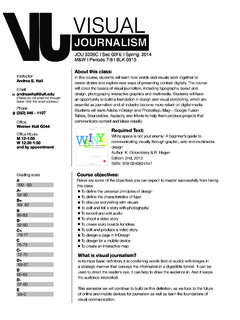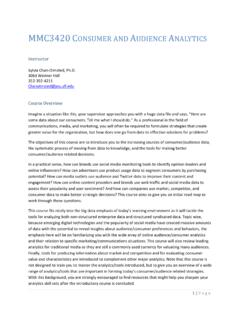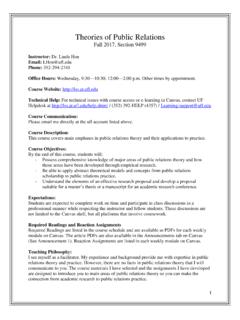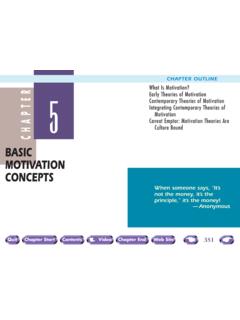Transcription of GUIDELINES FOR WRITING A THESIS OR DISSERTATION
1 GUIDELINES FOR WRITING A THESIS OR DISSERTATION CONTENTS: GUIDELINES for WRITING a THESIS or DISSERTATION , Linda Childers Hon, Outline for Empirical Master s Theses, Kurt Kent, How to Actually Complete A THESIS : Segmenting, Scheduling, and Rewarding, Kurt Kent, How to Make a THESIS Less Painful and More Satisfying (by Mickie Edwardson, Distinguished Professor of Telecommunication, Emeritus, ca. 1975), provided by Kurt Kent 2007-2008 2 GUIDELINES for WRITING a THESIS or DISSERTATION Linda Childers Hon Getting Started 1. Most research begins with a question. Think about which topics and theories you are interested in and what you would like to know more about. Think about the topics and theories you have studied in your program. Is there some question you feel the body of knowledge in your field does not answer adequately? 2. Once you have a question in mind, begin looking for information relevant to the topic and its theoretical framework.
2 Read everything you can--academic research, trade literature, and information in the popular press and on the Internet. 3. As you become well-informed about your topic and prior research on the topic, your knowledge should suggest a purpose for your THESIS / DISSERTATION . When you can articulate this purpose clearly, you are ready to write your prospectus/proposal. This document specifies the purpose of the study, significance of the study, a tentative review of the literature on the topic and its theoretical framework (a working bibliography should be attached), your research questions and/or hypotheses, and how you will collect and analyze your data (your proposed instrumentation should be attached). 4. At this point, master's students need to recruit committee members (if they haven't done so already) and hold a preliminary meeting. The purpose of this meeting is to refine your plans if needed and to make explicit expectations for completion of the THESIS .
3 Doctoral students discuss their DISSERTATION proposal as part of their qualifying exam. At the completion of this meeting, the student should submit a memo to committee members summarizing what was agreed upon during the meeting. 5. Once your instrumentation is developed, you need to clear it and your informed consent protocol with the Institutional Review Board before you begin collecting data. Leave adequate time to do so. The process can take several days or weeks. 6. Obviously, the next steps are collecting and analyzing data, WRITING up the findings, and composing the final chapter . You also should make sure Chapters 1 and 2 are now fully developed. Your chair and committee members provide guidance as needed at this point but expect you to work as independently as possible. 7. You should be prepared to hire assistance with coding and data entry and analysis if needed. 8. Get a copy of the graduate school's GUIDELINES for WRITING theses and dissertations and follow these GUIDELINES exactly.
4 WRITING 9. Each THESIS or DISSERTATION is unique but all share several common elements. The following is not an exact guide but rather a general outline. chapter 1: Purpose and Significance of the Study In the first chapter , clearly state what the purpose of the study is and explain the study's significance. The significance is addressed by discussing how the study adds to the theoretical body of knowledge in the field and the study's practical significance for communication professionals in the field being examined. students also must explain how their research makes an original contribution to the body of knowledge in their discipline. They also should address the significance of the study for mass communication education. It is especially critical that this chapter be well developed. Without a clearly defined purpose and strong theoretical grounding, the THESIS or DISSERTATION is fundamentally flawed from the outset. 3 chapter 2: Review of the Literature The purpose of the study should suggest some theoretical framework to be explained further in this chapter .
5 The literature review thus describes and analyzes previous research on the topic. This chapter , however, should not merely string together what other researchers have found. Rather, you should discuss and analyze the body of knowledge with the ultimate goal of determining what is known and is not known about the topic. This determination leads to your research questions and/or hypotheses. In some cases, of course, you may determine that replicating previous research is needed. chapter 3: Methodology This chapter describes and justifies the data gathering method used. This chapter also outlines how you analyzed your data. Begin by describing the method you chose and why this method was the most appropriate. In doing so, you should cite reference literature about the method. Next, detail every step of the data gathering and analysis process. Although this section varies depending on method and analysis technique chosen, many of the following areas typically are addressed: --description of research design internal validity external validity --description of population and description of and justification for type of sample used or method for selecting units of observation --development of instrument or method for making observations ( , question guide, categories for content analysis) pre-test reliability and validity of instrument or method --administration of instrument or method for making observations ( , interviews, observation, content analysis) --coding of data --description of data analysis statistical analysis and tests performed identification of themes/categories (qualitative or historical research) chapter 4.
6 Findings This chapter addresses the results from your data analysis only. This chapter does not include discussing other research literature or the implications of your findings. Usually you begin by outlining any descriptive or exploratory/confirmatory analyses ( , reliability tests, factor analysis) that were conducted. You next address the results of the tests of hypotheses. You then discuss any ex post facto analysis. Tables and/or figures should be used to illustrate and summarize all numeric information. For qualitative and historical research, this chapter usually is organized by the themes or categories uncovered in your research. If you have conducted focus groups or interviews, it is often appropriate to provide a brief descriptive ( , demographic) profile of the participants first. Direct quotation and paraphrasing of data from focus groups, interviews, or historical artifacts then are used to support the generalizations made. In some cases, this analysis also includes information from field notes or other interpretative data ( , life history information).
7 chapter 5: Discussion The purpose of this chapter is not just to reiterate what you found but rather to discuss what your findings mean in relation to the theoretical body of knowledge on the topic and your profession. Typically, students skimp on this chapter even though it may be the most important one because it answers the "So what?" question. Begin by discussing your findings in relation to the theoretical framework introduced in the literature review. In some cases, you may need to introduce new literature (particularly with qualitative research). This chapter also should address what your findings mean for communication professionals in the field being examined. In other words, what are the study's practical implications? Doctoral students also should discuss the pedagogical implications of the study. What does the study suggest for mass communication education? 4 This chapter next outlines the limitations of the study. Areas for future research then are proposed.
8 Obviously, the THESIS or DISSERTATION ends with a brief conclusion that provides closure. A strong final sentence should be written. Finishing 10. Do not expect to begin and finish your THESIS in the same semester. You need to make significant progress (which usually means you are already collecting data) the semester before you want to graduate. The defense is scheduled when the THESIS has been completed successfully--not when it is convenient for the student to graduate. Even if nothing goes wrong (and things often do), a quality THESIS takes about six to nine months to complete (from inception to graduate school clearance). Obviously, the same principles apply for dissertations as well but doctoral students must allot even more time. A quality DISSERTATION usually takes about a year to complete (best case scenario). 11. Do not expect your chair or committee members to copy edit your THESIS or DISSERTATION . Before turning in any drafts, you should carefully edit and spell check your work.
9 Editing occurs at two different levels at least. Micro editing involves correcting spelling and grammatical errors. It also involves checking for proper paragraph and sentence structure, consistent use of terms, and variety in word choice. Macro editing assesses the overall structure of the THESIS . This includes making sure each chapter flows logically from the previous chapter , headings and subheadings are used properly and consistently, and transitions are included between major topics. Macro editing also determines whether any parts of the THESIS need to be streamlined or expanded. In some cases, it may be necessary for you to hire a professional editor. 12. Leave time for the chair to read your completed THESIS or DISSERTATION at least twice before giving it to your committee members. Don't expect to submit the completed THESIS or DISSERTATION for the first time to the chair and defend in the same or following week. Also, it is customary to give the THESIS or DISSERTATION to committee members at least a week before the defense.
10 13. It is the student s responsibility to reserve a room for the defense and to bring the signature page and the examination form to the defense. 14. Be prepared for revisions after the defense. You can expedite clearance by the graduate school by letting the staff examine a draft of the THESIS or DISSERTATION before you defend. 15. It is customary to provide your chair and committee members with a bound copy of the final version of the THESIS or DISSERTATION . 5 Research Methods by Kurt Kent 3/27/2001 Outline for Empirical Master's Theses PROPOSAL. The following topics usually will be included. In addition to definitions in , define other terms where first used. Do use subheads throughout. chapter I. INTRODUCTION. A. Broad introduction to THESIS topic and method. Page or two. Write after remainder of proposal is completed. B. Research problem. State broadly, in question form. Give sub-questions. Explain carefully. In one sense, usually the problem is to expand the body of knowledge examined in the literature review.









